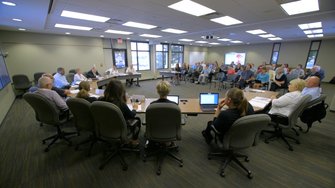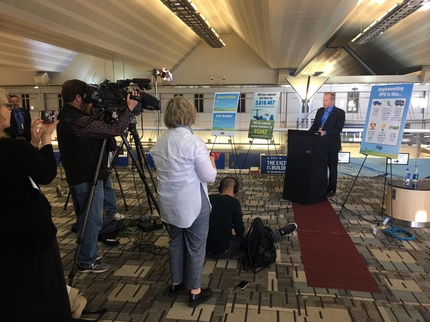 The Metropolitan Airports Commission (MAC) is producing a series of videos on the efforts at Minneapolis-St. Paul International Airport to minimize noise impacts.
The third video, found here, describes the Noise Oversight Committee, or NOC.
Pictured: The NOC at a recent public meeting.
The committee was established in August 2002 as an advisory board appointed to address aircraft noise issues associated with MSP.
The NOC is made up of community and aviation industry representatives who provide policy recommendations to the MAC.
The MAC's Noise Program Office website provides additional information about the video series and other outreach efforts.
|
New arrival procedures for aircraft at Minneapolis-St. Paul
International Airport (MSP) have resulted in the largest known air-quality
benefit of any single action in MSP’s history.
Measurements by the Metropolitan Airports Commission (MAC)
show the benefits of adopting Federal Aviation Administration (FAA) NextGen
aircraft arrival procedures.
The new arrival procedures implemented at MSP in March 2015
are called optimized profile descents, or OPD. Traditionally, when aircraft were approaching
the airport, pilots descended in stages through a series of procedures
involving reducing altitude, then leveling off, reducing altitude more and
leveling off again, and so on until they finally touched down.
 Using OPD, pilots continue flying at cruise altitude longer, and once they start their descent, they continue it until they land. Keeping the plane throttled back reduces fuel burn and associated greenhouse gas emissions.
Pictured: Brian Ryks, CEO and executive director of the MAC, discusses OPD at a recent media event.
Using data supplied by airlines and the FAA, the MAC has become the first airport operator in the nation to measure the impacts of OPD, and the results are impressive. The MAC estimates that airlines burn 2.9 million fewer gallons of fuel per year using OPD procedures than they would using traditional staged descents on approach to MSP.
As a result of the reduced fuel burn, arriving aircraft emit 28,465 fewer metric tons of carbon dioxide into the atmosphere annually than they otherwise would.
“The reduction in carbon dioxide emissions around MSP is the result of a cooperative effort by community leaders, airlines, the FAA and the Airports Commission to reduce environmental impacts while also improving the safety and efficiency of air traffic,” said Brian Ryks, executive director and CEO of the MAC. “This achievement demonstrates that the cooperative approach that has made MSP an industry leader at noise mitigation can also produce huge benefits in other areas, such as in reduced aircraft emissions.”
|
The Noise Oversight Committee (NOC), an advisory panel to the MAC consisting of community and airline representatives, endorsed adoption of NextGen OPD arrivals at MSP in 2014. At that time, the MAC committed to measuring use and air quality impacts of the procedures at MSP.
The MAC’s Environment Department created an analysis capability that uses data from the FAA, Delta, Sun Country and Endeavor airlines. The FAA then validated fuel and emissions savings results associated with OPD arrivals. While created to measure impacts around MSP, this methodology can be adapted to address local conditions at airports across the nation to quantify OPD’s benefits to their communities.
Since airlines began using OPD arrivals at MSP in March 2015, they have conserved more than 5.8 million gallons of fuel, saving an estimated $9.5 million in fuel costs and preventing more than 57,000 metric tons of carbon dioxide from entering the atmosphere. That’s the equivalent of removing more than 12,000 cars from the road, eliminating the energy used at 6,000 homes or planting 54,000 acres of forest.
“Delta has a longstanding and ongoing commitment to working with the Noise Oversight Committee, the MAC, the FAA and community leaders to reduce environmental impacts around MSP while also improving safety and efficiency,” said Bill Lentsch, senior vice president – Delta Connection and Global Services. “We are proud to have played a role in developing a tool to measure the effects of these new arrival procedures, and we congratulate all of our local partners for their environmental stewardship.”
Last month, Airports Council International-North America presented the MAC with a 2017 Environmental Achievement Award for developing a way to measure use and environmental benefits of OPD. The award recognized the MAC in the Innovative and Special Projects award category.
The award-winning OPD effort is part of a longstanding history of environmental stewardship at MSP. For more information about the MAC’s sustainability program, visit this website.
The Federal Aviation Administration (FAA) unveiled its new Data Communications technology at Minneapolis-St. Paul International Airport (MSP) recently, which enhances safety and provides for more efficient communications between pilots and air traffic controllers.
A media event at the FAA control tower at MSP on April 11 gave reporters a view of the technology in the tower and in the cockpit of a Delta Air Lines passenger jet.
 Pictured: Click on the photo to view a 360-degree image of MSP's control tower.
For years, air traffic controllers have used radio voice communications to give clearances and other detailed flight information to pilots. Such communications are time-consuming and can lead to “readback/hearback” errors.
Data Communications, or Data Comm for short, gives air traffic controllers and pilots the ability to transmit flight plans, clearances, instructions, advisories, flight crew requests and other essential messages as text on screens.
The change speeds up communications and enhances safety by reducing the chance of a read-back error while relaying information.
 The clickable video shows examples of the screens seen by pilots and controllers who use Data Comm.
Additionally, Data Comm allows controllers to send text instructions to several aircraft at once, a much more accurate and efficient process than numerous conversations.
The reporters who gathered at the FAA control tower facility at MSP on April 11 received a briefing on the Data Comm technology.
Representatives from the FAA, Delta Air Lines and the National Air Traffic Controllers Association spoke at the event. An audio recording provided an example of the cumbersome process of a controller reading a flight plan, the pilot reading it back, and then a third reading with errors and corrections going back and forth.
Reporters were also taken to the control tower to see the Data Comm system in use by air traffic controllers. Later, reporters visited the cockpit of a Delta 757, where Captain Jon Pendleton provided a Data Comm demonstration from the pilot’s perspective.
For airline passengers, the new technology can also mean shorter delays. During bad weather, for example, air traffic controllers may need to change a flight plan.
Communicating that over the radio while the plane waits in line to take off – with dozens of other planes waiting for similar information – can lead to a lengthy delay.
With Data Comm, those delays can be minimized, and a plane waiting in line could potentially be pulled out of the takeoff line and be sent directly to the runway ahead of other aircraft.
That change could also benefit the environment as jets burn less fuel while waiting in line to depart.
The FAA indicated it is now operating Data Comm services at 55 air traffic control towers and is more than two years ahead of schedule on implementation.
Two Metropolitan Airports Commission construction projects were recently recognized for their design and execution.
At Holman Field near downtown St. Paul, a runway and taxiway reconstruction project received a merit award from the Minnesota Department of Transportation, and a Project of the Year award from the Minnesota Council of Airports.
 A view of the reconstructed runways at Holman Field near downtown St. Paul.
The project separated the ends of two runways and reconfigured taxiways. The work addressed concerns from the Federal Aviation Administration about potential runway incursions.
To minimize disruption at the airport, the construction work was completed on a compressed schedule, with crews working 10 hour days six days a week.
At Minneapolis-St. Paul International Airport, reconstruction of concrete aprons located in and around boarding gates won a Merit Award from the Minnesota Department of Transportation, and an award from the Concrete Paving Association for the Best Project of its type.
The work on the aprons near gates that serve Concourse C was done in phases over two years. Slower times of the year at the airport include April-May and September-October, and crews worked during those periods to minimize disruption to normal flight activities.
Board Meetings
Business Opportunities
Career Opportunities
General Aviation Airport Information
MSP Aircraft Noise Information
MSP Airport
|